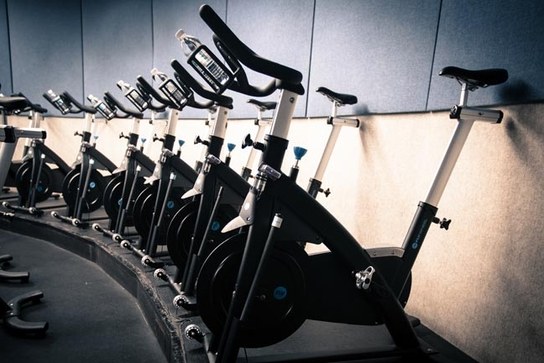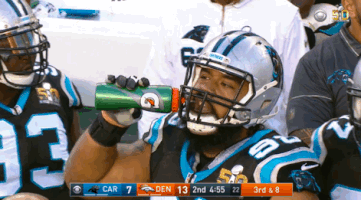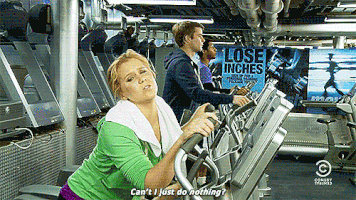So, have you officially decided to see what the hype is about “spinning” or “cycling”?
Spin and/or cycling classes (there is some debate about the difference between names) is often hailed for its low-impact but high-calorie burn workouts that get your heart pumping and the sweat pouring without destroying your joints. The streamline bikes with all the different knobs and adjustments may seem intimidating at first, but after the first class, you’ll get the hang of it.

Photo courtesy of teenvogue.com
While you’re there, the instructor will most likely explain the different positions of the class (position one through three) and what “levels” means (resistance). They will also offer tips throughout the class. Your form is very important, and so is listening to the instructors’ cues. If you’re going to go for a workout like cycling, you should want to get the most out of it.
1. Hydrate and eat something

Gif courtesy of giphy.com
You could be spending more than an hour on a bike, and while you will be able to take drinks during the workout, it is especially important to hydrate before going. This workout will require immense amounts of energy, so you should also have a light bite to eat anywhere as close to an hour to a half hour before.
Calories convert to energy, which will help give you a boost in your workout. Eating too close to a workout can cause nausea, but eating the right thing beforehand can make a huge difference. Often, it is recommended that you don’t exercise on an empty stomach because it can negatively impact your ability to perform.
2. Bring a towel and water because you are going to sweat… a lot

Gif courtesy of giphy.com
It would be helpful to have a water bottle with a squirt top that you don’t have to unscrew, so you can take drinks while in motion. The towel helps for your dripping forehead, and for drying your clammy hands that may start to slip on the handlebars.
3. Don’t stop pedaling

Gif courtesy of giphy.com
If you are tired, take resistance off the bike and slow down your RPMs. You should not, however, stop pedaling. One reason is because it is dangerous to slow your heart rate that quickly. A second reason is that it will be harder to get back in the momentum of the workout if you’ve stopped.
If you need to stop pedaling for any reason, do so carefully, and if you are getting off the bike, ensure your pedals come to a complete stop so you don’t fall off.
4. Arrive early

Gif courtesy of giphy.com
It can be extremely distracting to the instructor if you’re walking in the door after he or she has already started. Many cyclists also find it beneficial to arrive early and start slow pedaling on an easy resistance as a warm up before the warm up. It will help you get a feel for the bike and establish balance before you are thrown into a warm up with higher resistance and RPMs.
5. Ask for help setting up your bike

Gif courtesy of giphy.com
The instructor would rather you ask them how to properly set up your bike than to do a complete workout on a bike that doesn’t fit you. Not only will you not fully maximize your ride, but you could also hurt your body. Handlebars that are too low can cause back pain, or a seat that’s too high and causes your knees to lock out can hurt your knees and ankles. Write down the settings of your bike when you find the perfect ride. You will memorize them after a few classes.
6. The room is dark and the music is loud

Gif courtesy of giphy.com
Some people love it, some people don’t. The instructor normally synchronizes their workout with the music, and the fast beats can help pump you up to keep pedaling hard. The dim lights help keep the mood more relaxed and fun. You can try several different classes to find the music and atmosphere that best suits you, too.
7. Your butt is going to hurt for a while

Gif courtesy of giphy.com
This should go away after three or four classes. But the seats are HARD. Another possible remedy is to use your core to increase control how you switch between positions. Sit down gently to make it easier on your rear. That way you’re saving your tush and working on some abs.
8. Put your phone down

Gif courtesy of giphy.com
Part of a workout is the psychological sensation, and if your phone is distracting you, you are truly missing out. First, you will most likely miss some of the instructor’s cues. Second, if you’re holding your phone or leaning down to touch it on the handlebars, you are probably not using proper form. Imagine how much more gratified you will feel by the difficult workout you just completed if you are unplugged and present the entire time (PS – it wouldn’t hurt to ditch your cell phone at other times too).
9. Warm up and cool down

Gif courtesy of giphy.com
This is so important, especially the cool down. The warm up stretches you out and gets your muscles ready to be on a bike for an extended period of time. It helps to stretch your arms and shoulders because they tend to tense up during the ride. The cool down is especially vital in slowing your heart rate and loosening up the tense muscles again.
Listen to the instructor’s cues to start taking levels off of your bike to lessen the resistance and help bring your pulse in check. Your instructor might even talk you through a pulse check to see if you’re ready to get off the bike.
Stopping completely while your heart is beating too fast can cause lightheadedness and fainting. The stretching during cool down is helpful in loosening the muscles you were just working very hard, but it also feels amazing after being on a bike for so long.
10. Listen to your body

Gif courtesy of giphy.com
Ultimately, it is your ride. If something the instructor calls for doesn’t feel right, you are under no obligation to do it. You don’t have to hit the highest level resistance or the highest RPMs. Some people get more out of cycling with higher resistance, while others prefer less resistance but higher speeds.
After a few classes, you will learn what makes your cycling workout satisfying, and you will learn how to adjust accordingly. The beauty of cycling is that you can make it completely your own. Let the instructor’s cues serve as goals or benchmarks to help you improve.


